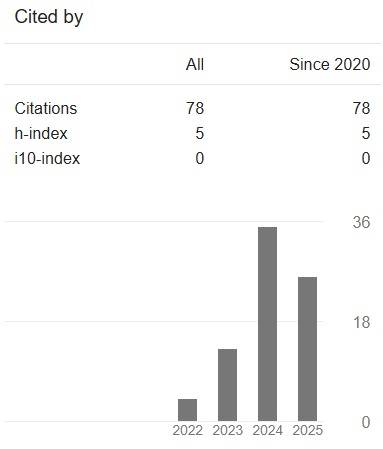Numerical Analysis on the Effect of Building Spacing and Podium on the Flow Structure Over High Rise Residential Buildings
DOI:
https://doi.org/10.24191/jaeds.v4i2.86Keywords:
wind comfort, urban flow, RANS, podium, pedestrian safetyAbstract
Urban environments with high-rise buildings often experience intensified wind speeds at the pedestrian level, which can compromise comfort and safety. The growing demand for urban housing has led to the proliferation of such buildings, but the impact of building geometry and configuration on local wind conditions remains underexplored, particularly concerning the presence of podium structures. This study addresses the critical issue of pedestrian-level wind (PLW) by investigating how the spacing between buildings and the inclusion of podiums affect wind dynamics. Using computational fluid dynamics (CFD) simulations, the study models wind flow around two high-rise residential buildings arranged back-to-back under different spacing configurations (0.16H, 0.31H, and 0.63H) with and without podiums. The primary objective is to assess wind speed ratios and vortex formations to identify optimal design configurations for enhancing pedestrian comfort and safety. The results show that building spacing of 0.31H without podiums yields the lowest wind speed ratio at the pedestrian level, enhancing safety. The introduction of a podium significantly alters wind flow patterns, particularly by increasing downwash flow and generating larger vortices above the podium level, which can exacerbate wind speeds at higher elevations. These findings underscore the importance of careful urban design considerations, particularly regarding building spacing and podium integration, to mitigate adverse wind effects. The study provides actionable insights for architects and urban planners to create wind-sensitive designs that improve the quality of life in densely built environments.
Downloads
References
T. van Druenen, T. van Hooff, H. Montazeri, and B. Blocken, “CFD evaluation of building geometry modifications to reduce pedestrian-level wind speed,” Build Environ, vol. 163, Oct. 2019, doi: 10.1016/j.buildenv.2019.106293.
T. Stathopoulos, “Pedestrian level winds and outdoor human comfort,” Journal of Wind Engineering and Industrial Aerodynamics, vol. 94, no. 11, pp. 769–780, Nov. 2006, doi: 10.1016/j.jweia.2006.06.011.
B. Blocken, T. Stathopoulos, and J. P. A. J. van Beeck, “Pedestrian-level wind conditions around buildings: Review of wind-tunnel and CFD techniques and their accuracy for wind comfort assessment,” Build Environ, vol. 100, pp. 50–81, May 01, 2016, Elsevier Ltd. doi: 10.1016/j.buildenv.2016.02.004.
Y. Tominaga and M. Shirzadi, “Wind tunnel measurement of three-dimensional turbulent flow structures around a building group: Impact of high-rise buildings on pedestrian wind environment,” Build Environ, vol. 206, Dec. 2021, doi: 10.1016/j.buildenv.2021.108389.
T. van Druenen, T. van Hooff, H. Montazeri, and B. Blocken, “CFD evaluation of building geometry modifications to reduce pedestrian-level wind speed,” Build Environ, vol. 163, Oct. 2019, doi: 10.1016/j.buildenv.2019.106293.
T. Stathopoulos, “Pedestrian level winds and outdoor human comfort,” Journal of Wind Engineering and Industrial Aerodynamics, vol. 94, no. 11, pp. 769–780, Nov. 2006, doi: 10.1016/j.jweia.2006.06.011.
B. Blocken, T. Stathopoulos, and J. P. A. J. van Beeck, “Pedestrian-level wind conditions around buildings: Review of wind-tunnel and CFD techniques and their accuracy for wind comfort assessment,” Build Environ, vol. 100, pp. 50–81, May 01, 2016, Elsevier Ltd. doi: 10.1016/j.buildenv.2016.02.004.
Y. Tominaga and M. Shirzadi, “Wind tunnel measurement of three-dimensional turbulent flow structures around a building group: Impact of high-rise buildings on pedestrian wind environment,” Build Environ, vol. 206, Dec. 2021, doi: 10.1016/j.buildenv.2021.108389.
S. Zhang and X. Xu, “Pedestrian level wind around super-Tall building: Effects of podium,” in IOP Conference Series: Earth and Environmental Science, Institute of Physics Publishing, Feb. 2019. doi: 10.1088/1755-1315/218/1/012036.
C. W. Tsang, K. C. S. Kwok, and P. A. Hitchcock, “Wind tunnel study of pedestrian level wind environment around tall buildings: Effects of building dimensions, separation and podium,” Build Environ, vol. 49, no. 1, pp. 167–181, 2012, doi: 10.1016/j.buildenv.2011.08.014.
H. Mittal, A. Sharma, and A. Gairola, “A review on the study of urban wind at the pedestrian level around buildings,” Jul. 01, 2018, Elsevier Ltd. doi: 10.1016/j.jobe.2018.03.006.
S. Murakami and H. Komine, “Amplification of Wind Speed at Ground Level due to Construction of High-Rise Building In Urban Area*,” Journal of Wind Engineering and Industrial Aerodynamics, vol. 4, no. 3-4, pp. 343-370, 1979.
X. Zhang et al., “Pedestrian wind comfort near a super-tall building with various configurations in an urban-like setting,” Build Simul, vol. 13, no. 6, pp. 1385–1408, Dec. 2020, doi: 10.1007/s12273-020-0658-6.
Y. Du and C. M. Mak, “Improving pedestrian level low wind velocity environment in high-density cities: A general framework and case study,” Sustain Cities Soc, vol. 42, pp. 314–324, Oct. 2018, doi: 10.1016/j.scs.2018.08.001.
Y. Tominaga et al., “AIJ guidelines for practical applications of CFD to pedestrian wind environment around buildings,” Journal of Wind Engineering and Industrial Aerodynamics, vol. 96, no. 10–11, pp. 1749–1761, Oct. 2008, doi: 10.1016/j.jweia.2008.02.058.
J. Franke, A. Hellsten, K. H. Schlünzen, and B. Carissimo, “The COST 732 Best Practice Guideline for CFD simulation of flows in the urban environment: A summary,” Int J Environ Pollut, vol. 44, no. 1–4, pp. 419–427, 2011, doi: 10.1504/IJEP.2011.038443.
Y. Tominaga and B. Blocken, “Wind tunnel analysis of flow and dispersion in cross-ventilated isolated buildings: Impact of opening positions,” Journal of Wind Engineering and Industrial Aerodynamics, vol. 155, pp. 74–88, Aug. 2016, doi: 10.1016/j.jweia.2016.05.007.
J. Liu and J. Niu, “CFD simulation of the wind environment around an isolated high-rise building: An evaluation of SRANS, LES and DES models,” Build Environ, vol. 96, pp. 91–106, Feb. 2016, doi: 10.1016/j.buildenv.2015.11.007.
R. F. Warming and R. M. Beam, “Upwind second-order difference schemes and applications in aerodynamic flows,” AIAA Journal, vol. 14, no. 9, pp. 1241–1249, 1976, doi: 10.2514/3.61457.
A. Harten, “High Resolution Schemes for Hyperbolic Conservation Laws,” J Computational Physics, vol. 49, no. 3, pp. 357-393, 1983, doi:10.1016/0021-9991(83)90136-5.
H. Tanaka, R. Yoshie, and C.-H. Hu, “Uncertainty in Measurements of Velocity and Concentration around a Building,” in the 4th International Symposium on Computational Wind Engineering, 2006, pp. 549–552.
Downloads
Published
How to Cite
Issue
Section
License
Copyright (c) 2024 Azerai Ali Rahman, Mohd Faizal Mohamad, Azli Abd Razak, Arba'ain Jaffar, Naoki Ikegaya

This work is licensed under a Creative Commons Attribution 4.0 International License.









